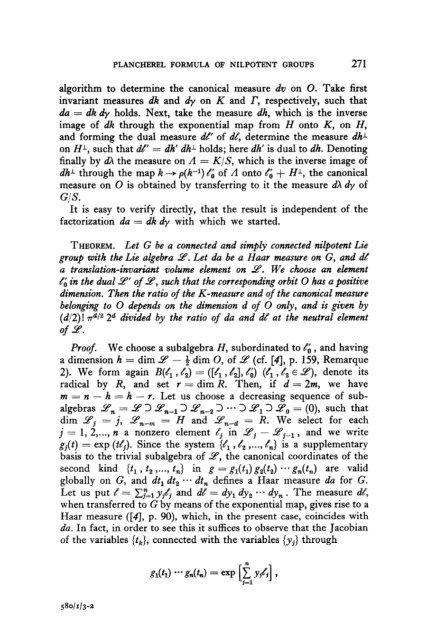On the Characters and the Plancherel Formula of Nilpotent Groups ...
On the Characters and the Plancherel Formula of Nilpotent Groups ...
On the Characters and the Plancherel Formula of Nilpotent Groups ...
You also want an ePaper? Increase the reach of your titles
YUMPU automatically turns print PDFs into web optimized ePapers that Google loves.
PLANCHEREL FORMULA OF NILPOTENT GROUPS 271<br />
algorithm to determine <strong>the</strong> canonical measure dw on 0. Take first<br />
invariant measures dk <strong>and</strong> dr on K <strong>and</strong> r, respectively, such that<br />
da = dk dr holds. Next, take <strong>the</strong> measure dh, which is <strong>the</strong> inverse<br />
image <strong>of</strong> dk through <strong>the</strong> exponential map from H onto K, on H,<br />
<strong>and</strong> forming <strong>the</strong> dual measure de’ <strong>of</strong> uY, determine <strong>the</strong> measure dhl<br />
on HJ-, such that aY” = dh’ dhl holds; here dh’ is dual to dh. Denoting<br />
finally by M <strong>the</strong> measure on A = K/S, which is <strong>the</strong> inverse image <strong>of</strong><br />
dhl through <strong>the</strong> map k -+ p(k-l) 4’; <strong>of</strong> A onto 8; + Hl, <strong>the</strong> canonical<br />
measure on 0 is obtained by transferring to it <strong>the</strong> measure dh dy <strong>of</strong><br />
G/S.<br />
It is easy to verify directly, that <strong>the</strong> result is independent <strong>of</strong> <strong>the</strong><br />
factorization da = dk dy with which we started.<br />
THEOREM. Let G be a connected <strong>and</strong> simply connected nilpotent Lie<br />
group with <strong>the</strong> Lie algebra 9. Let da be a Haar measure on G, <strong>and</strong> dr?<br />
a translation-invariant volume element on 3’. We choose an element<br />
e$ in <strong>the</strong> dual 9’ <strong>of</strong> 9, such that <strong>the</strong> corresponding orbit 0 has a positive<br />
dimension. Then <strong>the</strong> ratio <strong>of</strong> <strong>the</strong> K-measure <strong>and</strong> <strong>of</strong> <strong>the</strong> canonical measure<br />
belonging to 0 depends on <strong>the</strong> dimension d <strong>of</strong> 0 only, <strong>and</strong> is given by<br />
(d/2)! #I2 2d divided by <strong>the</strong> ratio <strong>of</strong> da <strong>and</strong> & at <strong>the</strong> neutral element<br />
<strong>of</strong> 3.<br />
Pro<strong>of</strong>. We choose a subalgebra H, subordinated to /i , <strong>and</strong> having<br />
a dimension h = dim 2 - Q dim 0, <strong>of</strong> 2 (cf. [4], p. 159, Remarque<br />
2). We form again B(4’i , f2) = ([/i , t2], Ci) (4, , e2 E g), denote its<br />
radical by R, <strong>and</strong> set r = dim R. Then, if d = 2m, we have<br />
m = n - h = h - r. Let us choose a decreasing sequence <strong>of</strong> subalgebras<br />
2% = 3’ 3 A?,+, 3 2%-Z 3 *** 3 .A?i 3 Z,, = (0), such that<br />
dim g* = j, g,-, = H <strong>and</strong> gnMd = R. We select for each<br />
j = 1, 2,..., n a nonzero element 8j in 3’j - gi-i , <strong>and</strong> we write<br />
gj(t) = exp (tt,). Since <strong>the</strong> system {/r ,4, ,..., &} is a supplementary<br />
basis to <strong>the</strong> trivial subalgebra <strong>of</strong> _Lp, <strong>the</strong> canonical coordinates <strong>of</strong> <strong>the</strong><br />
second kind {tl , t, ,..., tn} in g = g,( tl) gz(t2) *** gJt,J are valid<br />
globally on G, <strong>and</strong> dt, dt, *** dt, defines a Haar measure da for G.<br />
Let us put 4’ = cj”=i y& <strong>and</strong> de = dy, dy, se* dy, . The measure de,<br />
when transferred to G by means <strong>of</strong> <strong>the</strong> exponential map, gives rise to a<br />
Haar measure ([4], p. 90), which, in <strong>the</strong> present case, coincides with<br />
da. In fact, in order to see this it suffices to observe that <strong>the</strong> Jacobian<br />
<strong>of</strong> <strong>the</strong> variables {tk}, connected with <strong>the</strong> variables {yj} through<br />
580/1/3-z

















